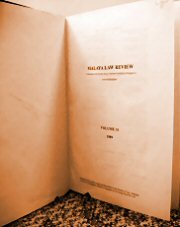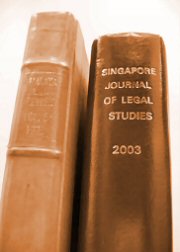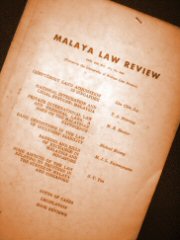| 371. | DECEMBER 2010 Issue | p.375 |
|
|
| Criminal Law Codification and Reform in Malaysia: An Overview
Norbani Mohamed Nazeri • [2010] Sing JLS 375 (Dec)This comment describes several of the most significant amendments to the Malaysian Penal Code in the past two decades. Sexual offences have featured prominently with changes made to the definition of rape and its penalty in order to afford greater protection to girls and women against sexual violence; a widening of the scope of unnatural offences; the creation of a version of the offence of marital rape; and new offences against the exploitation of persons for the purpose of prostitution. The offence of incest was also introduced into the Penal Code with resulting jurisdictional conflicts between the civil and Shariah courts, which the author contends should be resolved by the Penal Code taking precedent. Other amendments discussed in this comment are a reverse onus presumption provision for the offences of criminal misappropriation and criminal breach of trust; anti-terrorism legislation in the aftermath of 9/11; and an increased maximum penalty structure for serious offences.
|
| 372. | DECEMBER 2010 Issue | p.400 |
|
|
| Contracting Under Lawful Act Duress
Nathan Tamblyn • [2010] Sing JLS 400 (Dec)The core context of duress considered here is where one party (the 'duressor') threatens to do something, to avoid which the party threatened (the 'duressee') accedes to the duressor's demands and contracts with him on his terms. If what the duressor threatens to do is unlawful, the contract can be set aside, and restitution can be had of any benefits transferred. Unlawful act duress includes duress to the person, duress of goods, and threatened breach of contract. Do the same consequences follow if what the duressor threatens to do is lawful in itself? This is lawful act duress.
|
| 373. | DECEMBER 2010 Issue | p.417 |
|
|
| Birthing the Lawyer: The Impact of Three Years of Law School on Law Students in the National University of Singapore
Tan Seow Hon • [2010] Sing JLS 417 (Dec)This article examines the impact of law school and legal education on the moral and professional identities of law students through surveys and interviews of law students from the Class of 2010 at the National University of Singapore. Questions were asked to ascertain how students viewed the relationship between their personal convictions and professionalism, what they thought of lawyers and the work they would do as lawyers in future, student's opinions as to law's relationship with justice, morality and other social phenomena, and students' expectations of legal education. This article seeks to increase consciousness of how law school is remaking students and developing the moral and professional identities of future lawyers, and to facilitate conversation that reshapes legal education to achieve its aims.
|
| 374. | DECEMBER 2010 Issue | p.459 |
|
|
| The Salient Features of Proximity: Examining the Spandeck Formulation for Establishing a Duty of Care
David Tan • [2010] Sing JLS 459 (Dec)The articulation of a single two-stage test by the Singapore Court of Appeal to determine the imposition of a duty of care in negligence for all types of damage claimed and for all factual scenarios is an admirable effort to bring doctrinal clarity to the neighbourhood principle. However, the notion of proximity which forms the cornerstone of the Spandeck test can benefit from a more methodical examination of a set of factual factors relevant to the relationship between the parties to the dispute. This article argues that the salient features approach of the High Court of Australia may be modified and adapted to assist Singapore courts in their analysis of "proximity" under the Spandeck formulation, and would be of significant practical benefit to judges and lawyers in their appraisement of the factual matrix.
|
| 375. | DECEMBER 2010 Issue | p.484 |
|
|
| Contentious Liberty: Regulating Religious Propagation in a Multi-Religious Secular Democracy
Thio Li-ann • [2010] Sing JLS 484 (Dec)This article examines the theoretical justifications, historical origins and contemporary scope of the constitutional liberty of religious propagation, against the competing interests clothing it with a controversial character. To elucidate the quality of religious freedom within a secular democracy and the meaning of associated concepts of 'tolerance', 'pluralism and citizenship, in Singapore, it examines how the state regulates this external dimension of religious liberty, whether through legislative sanction or soft constitutional lawnorms seeking to promote compliance with non-binding government articulated standards. Two recent 'cautionary tales' are analysed to ascertain the contours of religious propagation in practice: the 2009 decision of PP v. Ong Kian Cheong where religious propagation fell afoul of sedition law, and the non-judicial management of the 'Lighthouse Evangelism' controversy where the authorities received complaints from offended Buddhists, Taoists and unaffiliated netizens about a church website video containing 'insensitive' comments.
|
| 376. | DECEMBER 2010 Issue | p.516 |
|
|
| Case and Legislation Comments: The Division of Matrimonial Assets: A Mathematical Methodology as a "Check"?
Chen Siyuan • [2010] Sing JLS 516 (Dec)In a recent High Court decision concerning the division of matrimonial assets, the Judge developed an extensive (and somewhat mathematical) methodology "as a rough check" to his discretionary powers in determining a "just and equitable" division of the matrimonial assets. This introduced a new perspective to an exercise long considered to be impossible to be mathematically precise. This piece considers the extent of the utility of the new methodology.
|
| 377. | DECEMBER 2010 Issue | p.530 |
|
|
| Case and Legislation Comments: Two Contrasting Approaches in the Interpretation of Outdated Statutory Provisions
Goh Yihan • [2010] Sing JLS 530 (Dec)Some statutes in operation today were passed a long time ago. Inevitably, through the passage of time, social norms at the time of enactment may now be unrecognisable. The legislative intent at the time of enactment may also seem outdated in more modern times. Judges interpreting specific provisions of these statutes may therefore encounter problems in ensuring a 'just' result in an instant case. Two recent cases show contrasting approaches towards the interpretation of outdated statutory provisions.
|
| 378. | DECEMBER 2010 Issue | p.546 |
|
|
| Case and Legislation Comments: Deferred Indefeasibility Reinstated in the Malaysian Torrens System: The End of an Unfortunate Saga
Teo Keang Sood • [2010] Sing JLS 546 (Dec)The earlier decision of the Malaysian Federal Court in Adorna Properties Sdn. Bhd. V. Boonsom Boonyanit @ Sun Yok Eng had not only spawned academic articles on the subject of indefeasibility of title and interests under the National Land Code 19654 ("the NLC") but had, unfortunately, also left an unwanted trail of uncertainty and insecurity of title for landowners which the Torrens system of land registration embodied in the NLC seeks to avoid, not to mention the slew of conflicting decisions pronounced in its aftermath.
|
| 379. | DECEMBER 2010 Issue | p.558 |
|
|
| Case and Legislation Comments: "It is a Little Known Legal Fact": Originalism, Customary Human Rights Law and Constitutional Interpretation
Thio Li-ann • [2010] Sing JLS 558 (Dec)The judicial approach towards constitutional interpretation, in attributing meaning to words in the constitutional text, illumines judicial self-understanding of institutional competence, howthe separation of powers animates or constrains judicial review, and where the fount of judicial legitimacy lies.
|
| 380. | DECEMBER 2010 Issue | p.571 |
|
|
| Case and Legislation Comments: The Search to Ascertain the Parties' Imputed Intentions
Wu Zhuang-Hui • [2010] Sing JLS 571 (Dec)The division of an unmarried couple's beneficial interests in property following their separation remains a conundrum. In the House of Lords decision of Stack v. Dowden,2 Baroness Hale remarked that the search is to ascertain the parties' shared intentions-actual, inferred or imputed.Yet the House of Lords did not explain exactly how such an intention could be imputed. Later cases applying Stack seem to have also neglected this possibility of imputation. The recent English Court of Appeal decision of Kernott v. Jones is important because it demonstrates that there are no less than three different ways to interpret this test in Stack. What is striking is that one of the three judgments had even taken into account events after the parties' separation when imputing their shared intentions. Although the Singapore courts have yet to consider whether or not to follow this approach in Stack, it is submitted that it is inevitable that this issue will come before our courts. Kernott makes clear the inherent difficulties in adopting the approach in Stack and the clarifications that our courts will need to make.
|
|







